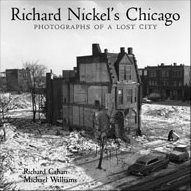 Half a dozen years ago, just as I was getting ready to make the move to Chicago, I saw the Lookingglass Theater production of They All Fall Down -- which told the story of Richard Nickel, the photographer turned salvager who waged a losing campaign against the wrecking ball in an effort to save the Chicago buildings of Adler and Sullivan and then, as time went by, tried to save all the historic architecture of Chicago that he could.
Half a dozen years ago, just as I was getting ready to make the move to Chicago, I saw the Lookingglass Theater production of They All Fall Down -- which told the story of Richard Nickel, the photographer turned salvager who waged a losing campaign against the wrecking ball in an effort to save the Chicago buildings of Adler and Sullivan and then, as time went by, tried to save all the historic architecture of Chicago that he could.Louis Sullivan was Frank Lloyd Wright’s mentor and employer – FLW called him Leibermeister – and he was arguably one of the first architects to forge a distinctly organic American style of architecture.
The Lookingglass production portrayed Nickel as something of a geek and a freak – you feel pity for the poor guy as he wages his campaign with his camera hanging perpetually round his neck -- but he was so awkward that you (that I) never entirely sympathized with his plight. And it certainly never became my problem.
City Files Press has published a book that just changed my idea about who Nickel was and what he did. I picked it up today at the Chicago History Museum after the Sullivan Symposium wrapped up, without realizing that it’s hot off the presses – the Chicago Tribune is running a portfolio of some of the shots in the book this weekend in their Sunday Magazine – and popped it open tonight to see what it had going on.
It’s a simple collection of Richard Nickels' photographs – many of which have never been printed before – peppered with brief excerpts from his writings and letters. He covers two thirds of the trinity that concerned his friend and mentor, Harry Callahan -- limiting himself to People and Buildings (Nature appears in Nickel’s work only in the detailed terracotta of Sullivan’s facades, or the imminent encroachment of a weedy lot) – but his work introduces pathos in a way that Callahan’s does not – it’s a powerful ache that something is not right – that everything must be turned on its head if things are going to turn out okay – but that turning never happens. One by one we watch, through Nickle’s eyes, the glorious structures erected by Adler and Sullivan – and other Chicago landmarks -- demolished to make way for parking garages and featureless office buildings.
The passage of pages in Richard Nickel’s Chicago: Photographs of a Lost City has the same chilling effect that creeps up when Cassandra starts tugging at our sleeve – that poor gal who warned the lugheads of the Iliad that their actions would lead to terrible consequences, knowing of course that no one – absolutely no one – was listening.
But still she was compelled to prophesize. And so was Richard Nickel.
Nickel fell in love near the end of his life. He promised his sweetie he’d pull back on being such a pitbull on the conservation issues. He bought a building of his own and started renovations – something he could save. “I should have owned a building several years ago,” he said. “I enjoy all the steps I am going through, but I worry if I will ever make it.”
He was right to worry. In 1972 he made a salvage trip to Adler and Sullivan’s Chicago Stock Exchange, which was then under demolition. He had photographed it on previous trips – photographs that would be used to reconstruct the trading floor at the Art Institute of Chicago.
It was late, he was alone, and no one’s entirely sure what happened next. All that is known is that he was buried so badly in the rubble it took 28 days for construction workers to recover his body.
I knew that going in, of course, but I didn’t know how deeply I’d be moved by Nickel's images. Not only of the buildings, but also of the kids on the South Side playing under Sullivan’s arches, and of the self-portraits that showed not a freak and not a geek – but a man who cared deeply about what he was trying to save. And who worked like hell to make someone else care too.
The book hit me the way some movies do when they strike something deep and sleeping (Wim Wenders Paris, Texas affected me this way) – I was relatively still as I paged my way through the 200 some pages, and then, when the last page was turned, I closed the cover and had myself a good cry.
The problem with landmarks – the basic problem – is that material things are short-lived, easily replaceable in the USA. ~ Richard Nickel






2 comments:
what a post....thank you....
excellent. Has it been six years already? wow.
Post a Comment